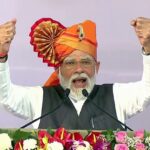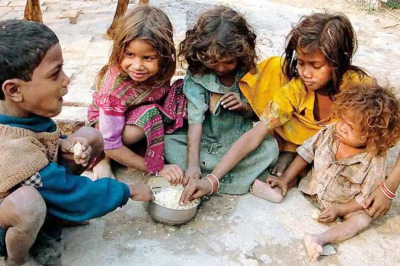Man must eat to live. A few months ago, the world hunger index was published which has created a sharp reaction from Indian Government as India’s position has deteriorated further this year and that too, below the ranking of Sri Lanka, Bangladesh and Nepal. India has objected to the methodology of sample collection that is full of contradiction. The percentage change in improving the position from 2000-21 has been 29.1 %, still India scores low in some areas of concern like policy implementation and effectiveness of Government programme.
The fight against hunger is dangerously off-track, food security is under assault from multiple fronts,climate change, COVID-19 pandemic has far reaching consequences on food security, which has exacerbated disproportionate inequalities and has produced cracks in food delivery system. World Hunger Index (WHI) is determined by four factors like under nourishment, child stunting, child wasting and child mortality. The resilience of food system is under pressure. World over, the GHI is a measure of development outcomes in the domain of hunger and India’s ranking is 101 in a pool of 116 nations. The level of hunger has been categorized as per its severity such as: extremely alarming, alarming, serious, moderate and low level of hunger. Therefore, food production remains to be streamlined and supply system has to be more realistic. Notwithstanding the fact, the war and conflicts in many parts of the world as well as severe cases of famine has cast its’ shadow on supply of food to all. Crop failure due to drought and climate change, low agricultural productivity, are crucial factors that needs to be improved so as to eliminate world hunger.
World Food Summit of 1996 which was held in Rome, echoed a call for right to food and freedom from hunger. The ‘Rome declaration’ on food security, laid emphasis on the right of every person ‘Right to food’. Everyone needs to have an access to adequate food throughout the year. The 2010 ‘Millennium Development Goal’ of United Nations, highlighted the challenges the world was facing in the food shortage and continues to face the crisis, leading to world poverty, and extreme hunger, lack of nutrition, undernourishment and resultant socio-economic tension.
We all know, Agriculture is the lifeblood of civilization. Mankind’s biggest problem is how to feed the teeming millions
and the same is possible by increasing production and revitalizing agriculture. It is estimated that the global population will continue to grow and UN demographics predict that there will be eleven billion people by the year 2100 and ten
billion by 2050. To meet the global demand of food, which we will encounter in the next 30 years so as to ensure continuous supply of food to the human kind and uplift them from pangs of hunger. The food requirement for the next decades would be an equivalent of food which was grown in last 10,000 years. This calls for increase of food production by all countries by 60 to 70 percent. The countries will have the ability to feed the world by modernizing
agriculture, adopting best practices, using high quality seeds, mechanized farming, application of sensor technology, use of artificial intelligence, bioengineering. Thus, the panacea lies in adaptation and mitigation of the food crisis.
The pace of change in Agriculture needs to percolate to the farmers, the cultivation must cater to changes in dietary habits, food preferences, and cultivation of food also needs to meet our nutrition requirement. Food is the new religion in the modern life and most of us believe that sustainable agriculture is the reply to such a necessity. To make agriculture sustainable, governments in the world must embrace technology, improve soil health, provide clean water,
revamp irrigation system, and maintain a balance of greenhouse gases, improve the quality of animal husbandry and cultivating climate smart crops with use of proper manure and fertilizer, and finally embracing the adoption of genetically modified crops for better production and productivity.
In the book, ‘Food 5.0’, Robert D Saik says, “Agriculture 5.0,which we are entering today is the result of technological advance such as smart phones, telecommunication, data management, computing power, GPS and robotics. On top of it, the Governments should streamline policy implementation, ensure better distribution and keep the wheels of agri-supply moving with proper storage.
The green revolution in India enabled the growth in food production and productivity with commensurate ills. Moreover, there was no public sector investment that could have driven agriculture from subsistence level to sustainable level.
Large number of programmes like Antyodaya Anna Yojana, food for work, child development programme like ICDS (Integrated Child Development Services), POSHAN 2.0, Mid-day meal scheme, National Food Security Act 2013, Pradhan Mantri Garib Kalyan Anna Yojana and other initiatives which has gone a long way to mitigate the problem of hunger in India. India is pursuing hard the goal of zero hunger which aligns with the Sustainable Development Goal of 2030, after the latest publication of world hunger index report to ensure the best outcomes so that everybody receives two square meal every day and the world can rest in peace.
In this regard, the role of World Food Programme, World’s largest humanitarian organization which focuses on hunger and food security and is also the largest provider of school meals. This organization was founded in 1961, and received Nobel peace prize in 2020 for saving and changing lives, delivering food assistance in emergencies and working with communities to improve nutrition and building resilience. Thus, it plays a crucial role in eliminating hunger from the world.
The Right to freedom from hunger is termed by article 11.2 of International Covenant on Economic, Social and Cultural rights, as a fundamental right. As per the Covenant, states have to improve the method of production, conservation and distribution of food including specific programs like developing or reforming agrarian system. The lawmakers of the various governments in the world in general and Indian Government in particular, have to take bold reforms and measures to make the world hunger free. Let us all work together to free the world from the pangs of hunger.
By Suresh Chandra Sarangi
Former General Manager,
Bank of India











More Stories
IPL: For Bumrah every ball wicket-taking delivery
J&K to get statehood, assembly elections not far: PM
Kohli fitness benchmarks among few: Ajit Agarkar